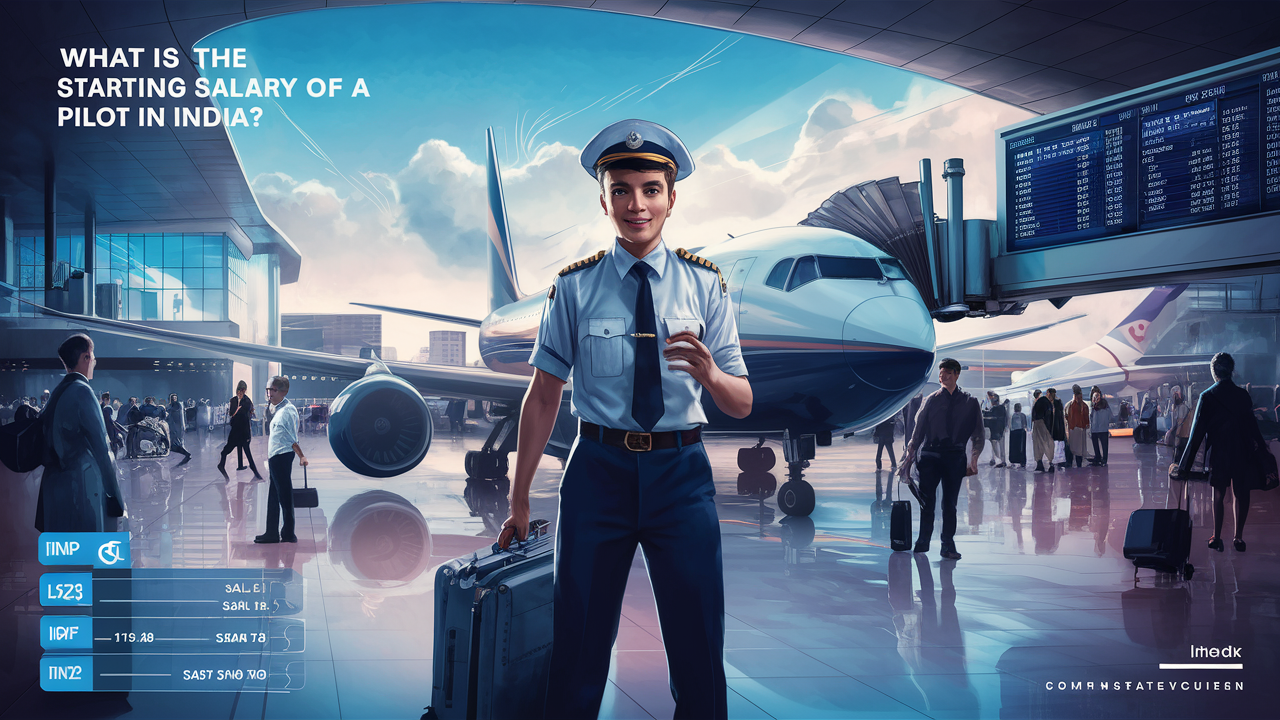What is the starting salary of a pilot in India?

Another occupation that is a dream of many young Indians is a pilot. Besides the pleasures of the job and the status that is attached to it, the attractive remunerations that pilots receive for their jobs are a major incentive for most prospective plane pilots. However, the trend toward starting the pay scale of a pilot in India is not definite with the above-mentioned indicators of qualification, airline, type of aircraft, etc.
However, the mean wage for pilots when they first join the company is between Rs. 5-8 lakhs per annum. This applies to commercial pilots flying major passenger-carrying planes and co-pilots, and first officers as well. New airline captains can be paid as low as Rs. 3-4 lakhs depending on the company they work for, while more experienced airline captains can earn between Rs. 12-15 lakhs annually after several years of flying. Let's take a deeper look at pilot salaries for different types of aviators:
Commercial Airline Pilots The issue of remuneration of airline pilots in India, especially the starting salary, can be said to be in direct proportion to the specific airline. This compensation is offered only by full-service carriers like Air India, Jet Airways, and Indigo, and commanders passing through the later stages of their careers enjoy better remuneration. Even the new generation of commercial pilots receive good pay, which is received in their pay packet.
In terms of monetary remuneration, a first officer or co-pilot hired under a fresh commercial airline placement can make about Rs. 5-7 lakhs annually, besides the multiple cash and flight allowances. As for the experienced captains and airline commanders, the total wages for the year are comparatively higher; the average sum is Rs. 12–15 lakhs.
Contrary to other airline carriers, some low-cost budget airlines pay a little less for their first officers, roughly between Rs. 3. 5 to 5 lakhs, and for captains between Rs. 8 to 10 lakhs. However, salaries rise with experience and flight time, though not as steep as training and qualification costs.
Besides the attractive remunerations, airline pilots are also entitled to other benefits such as free or reduced fares for themselves, their families, and friends, bonuses, and good retirement packages. It is exciting and well-remunerated and offers good working conditions that can be likened to any other profession in India.
Charter/Corporate Jet Pilots Apart from the airlines, pilots can also find employment with non-scheduled operators charter flight companies, or private corporate aviation entities. It is thus flexible, with the starting salaries being slightly low compared to the airlines.
Starting pay of a co-pilot at a low-profile charter operator flying a small turboprop airplane may expect to be paid around Rs. 2.5-4 lakhs per year. The new entrants in reputed business aviation firms or large commercial charter companies are given a package of 3.5 lakh to 6 lakhs per annum. A chairman of midsize business jets may earn Rs. 8–12 lakhs.
The charter/business aviation sector is relatively less secure in terms of employment prospects for pilots than the commercial aviation sector. But for young pilots, they offer the best chance of building up domestic and international flight hours, thus making it easier to get a place with an airline later.
Helicopter Pilots, There is a high demand for helicopters for transportation, emergencies, tourist attractions, and other purposes in India. A person must obtain a rotary wing commercial pilot license along with an instrument rating to become a helicopter pilot.
The rookie co-pilots are paid a relatively lesser amount; their basic wage starts from 3 to 5 lakh rupees per year, which can vary depending on the company and type of aircraft. Corporations that are into power and infrastructure, companies that deal with charter services, and owners of ME helicopters provide better remuneration.
Experienced senior captains who fly helicopters and the training pilots for these services can expect to earn Rs. 8–12 lakhs for high-paying charter/corporate jobs. But most pilots would take many years to acquire such experience, starting from being a co-pilot in small helicopters.
Flight Instructors Gaining the necessary hours for a license to be an airline pilot requires the person to first become a junior flight instructor most of the time. Several flying clubs, academies, and institutes recruit newly qualified commercial pilots to train a succession of students.
The median annual wage paid to these novice flight instructors is surprisingly low, around INR 2.5–4 lakhs per annum. This way, young pilots can make a little income as they search for more flights in light aircraft to meet the experience requirements for airline placements.
The commercial license trainers, especially the senior ones who are preparing the aspirant, can earn between Rs. 5-8 lakhs depending on their experience, esteem, and the employer institute. Certified flight examiners and check pilots may elevate earnings in the aviation industry.
Salary Growth Prospects As I have indicated, entry-level salaries in flying jobs are relatively average, but promotion and experience that go hand in hand with hours flown advance the ladder from co-pilot, pilot, and captain to leading senior airline commander.
There is an expectation that the pilot may at least double or triple his starting salary within 5-8 years after their entry-level pay package. High-experience pilots with over a thousand flight hours are considered some of the highest-paid workers in the country, earning handsome paychecks.
Conclusion A pilot profession is lucrative as well as enriching personal experience in India. Although pilots’ beginner salaries might seem low and associated with rookie status, the further increase in the pilots’ salaries is impressive, and the beginning pilots can earn as much as they can in different other fields after several years only. Apart from reasonable remuneration, the pilot gets other privileges such as recognition, thrill, and eventual promotion to managerial positions in the organization at later stages of their flying careers.
